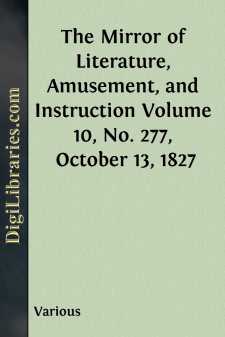Categories
- Antiques & Collectibles 13
- Architecture 36
- Art 48
- Bibles 22
- Biography & Autobiography 813
- Body, Mind & Spirit 142
- Business & Economics 28
- Children's Books 16
- Children's Fiction 13
- Computers 4
- Cooking 94
- Crafts & Hobbies 4
- Drama 346
- Education 46
- Family & Relationships 57
- Fiction 11829
- Games 19
- Gardening 17
- Health & Fitness 34
- History 1377
- House & Home 1
- Humor 147
- Juvenile Fiction 1873
- Juvenile Nonfiction 202
- Language Arts & Disciplines 88
- Law 16
- Literary Collections 686
- Literary Criticism 179
- Mathematics 13
- Medical 41
- Music 40
- Nature 179
- Non-Classifiable 1768
- Performing Arts 7
- Periodicals 1453
- Philosophy 64
- Photography 2
- Poetry 896
- Political Science 203
- Psychology 42
- Reference 154
- Religion 513
- Science 126
- Self-Help 84
- Social Science 81
- Sports & Recreation 34
- Study Aids 3
- Technology & Engineering 59
- Transportation 23
- Travel 463
- True Crime 29
The Mirror of Literature, Amusement, and Instruction Volume 10, No. 277, October 13, 1827
by: Various
Categories:
Description:
Excerpt
THE PALACE AT STOCKHOLM.
The palace at Stockholm is the redeeming grace of that city.—Stockholm "not being able to boast any considerable place or square, nor indeed any street wider than an English lane; the exterior of the houses is dirty, the architecture shabby, and all strikes as very low and confined. Yet the palace must be excepted; and that is commanding, and in a grand and simple taste." Such is the description of Stockholm by Sir Robert Ker Porter; but, as he admits, he had just left the city of St. Petersburgh, and being probably dazzled with the freshness of its splendour, Stockholm suffered in the contrast.
But Sir R.K. Porter is not entirely unsupported in his opinion. Mr. James, in his interesting "Journal of a Tour in Sweden, &c." published in 1816, describes the suburbs of Stockholm as "uniting every beauty of wild nature, with the charms attendant upon the scenes of more active life; but the examples of architecture within the town, if we except the mansions of the royal family, are not of a style at all corresponding with these delightful environs. The private houses make but little show; and the general air of the public buildings is not of the first style of magnitude, or in any way remarkable for good taste. One point, however, may be selected, that exhibits in a single prospect all that the capital can boast of this description. There is a long bridge of granite, connecting the city in the centre with the northern quarters of the town: immediately at one extremity rises the royal palace, a large square edifice, with extensive wings, and of the most simple and elegant contour; the other extremity is terminated by an equestrian statue of Gustavus Adolphus, forming the chief object of a square, that is bounded on the sides by handsome edifices of the Corinthian order; one the palace of the Princess Sophia, the other the Italian Opera-house."
Mr. A. de Capell Brooke, who visited Stockholm in the summer of 1820, describes the palace as "a beautiful and conspicuous object, its walls washed by the Baltic."—It is square, on an elevated ground, has a spacious court in the centre, and is in every respect worthy a royal residence. Near the entrance are two large bronze lions, which are admirably executed. "The view of the palace from the water," says Sir R.K. Porter, "reminds us of Somerset House, though it far exceeds the British structure in size, magnificence, and sound architecture." It contains some good paintings, and a fine gallery of statues, chiefly antique, collected by the taste and munificence of Gustavus III. The Endymion is a chef d'œuvre of its kind, and the Raphael china is of infinite value, but a splendid example of genius and talent misapplied.
All travellers concur in their admiration of the site and environs of Stockholm, and in deprecating the malappropriation of the former, Porter says, "The situation of this capital deserves finer edifices. Like St. Petersburg, it is built on islands; seven, of different extent, form its basis; they lie between the Baltic and the Malar lake....












